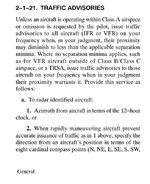That these aircraft are VFR is not my concern.
Question: Is it acceptable for a controller (not radar certified) at a VFR tower to advise VFR aircraft to maintain visual separation from each other. OR issue traffic per the clock "1:00, 2 miles", versus ahead and to your right". From what I can find, the 7110 only addresses certified and non-certified equipment, and doesn't mention the rating or ability of the controller. I've been trained that giving these type of clearance is giving a VFR pilot the illusion / false sense of security that they are or have been receiving radar service, something the 7110 does address. Thoughts???
Question: Is it acceptable for a controller (not radar certified) at a VFR tower to advise VFR aircraft to maintain visual separation from each other. OR issue traffic per the clock "1:00, 2 miles", versus ahead and to your right". From what I can find, the 7110 only addresses certified and non-certified equipment, and doesn't mention the rating or ability of the controller. I've been trained that giving these type of clearance is giving a VFR pilot the illusion / false sense of security that they are or have been receiving radar service, something the 7110 does address. Thoughts???
